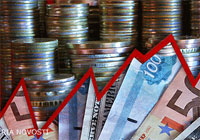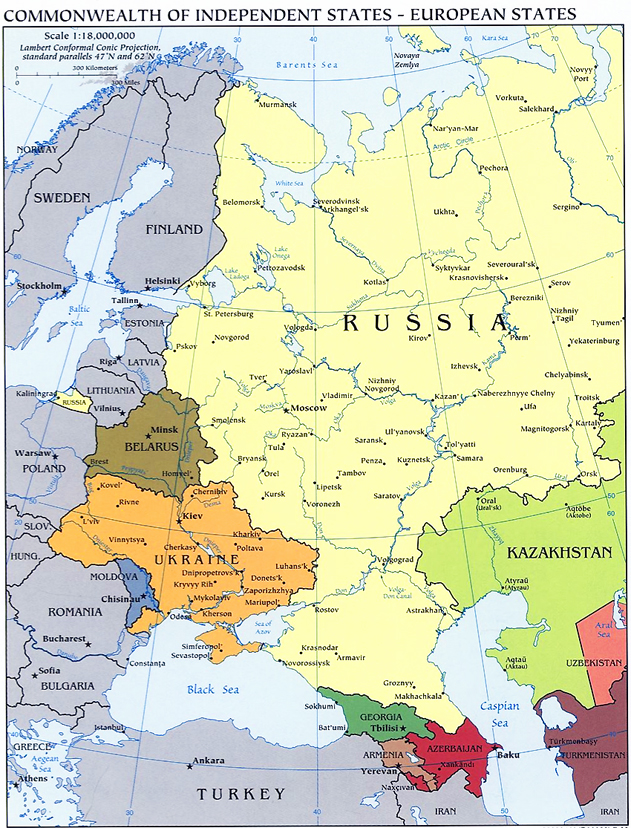Russia Recession Risk Seen Rising on Sanctions

(Bloomberg – bloomberg.com – Anna Andrianova and Andre Tartar – April 29, 2014) Russia faces a fifty-fifty chance of recession, the highest since Bloomberg started to track the measure, as the crisis in Ukraine raises the risk of further sanctions, according to a survey of economists.
The probability of a recession over the next 12 months rose to 50 percent, the highest since the first such Bloomberg survey in June 2012, according to the median estimate of eight economists surveyed before the U.S. and the European Union announced their latest salvo of sanctions yesterday. The gauge was at 45 percent last month.
Russia’s annexation of Crimea a month ago prompted the U.S. and EU sanctions, threatening to tip the $2 trillion economy into a recession. Capital outflow amounted to $50.6 billion in the first three months of 2014 from $27.5 billion a year earlier. That compares with $63 bil lion in all of 2013.
“Given that tensions remain so high over Ukraine issues, capital flight is likely to continue at a fairly intense pace,” Charles Movit, an economist at IHS Global Insight in Washington, said by phone. “The weaker ruble has taken a toll on consumer purchasing power so we expect further slowdown of product consumption.”
Gross domestic product gained an estimated 0.9 percent from a year earlier in March, bringing first-quarter expansion to 0.8 percent, the Economy Ministry said today. Economic growth unexpectedly accelerated in October-December, advancing 2 percent from the same period a year earlier, compared with 1.3 percent in the third quarter.
More Sanctions
The U.S. yesterday imposed additional sanctions on seven Russian officials and 17 companies linked to President Vladimir Putin’s inner circle, saying Russia “has done nothing” to meet its Geneva commitments to de-escalate the crisis. The EU added 15 names to its b lacklist.
Deputy Minister Dmitry Kozak was the only one sanctioned by both the EU and the U.S. The EU also imposed penalties on separatist leaders in Ukraine.
Russian stocks and bonds climbed for a second day and the ruble advanced after a new round of international sanctions bypassed the country’s major companies and banks.
The dollar-denominated RTS (RTSI$) stock index, which has suffered the world’s worst losses this year as Putin annexed Ukraine’s Crimea peninsula, gained 1.4 percent to 1,155.56 today.
The ruble gained for a second day, strengthening 0.6 percent to 35.59 per U.S. currency. The Russian currency has lost 7.7 percent this year against the dollar, the second-worst performance among 24 emerging-market currencies tracked by Bloomberg after Argentina’s peso.
U.S. Warning
U.S. Attorney General Eric Holder said today in London that the U.S. is prepared to impose further sanctions if Russia fails to “cease i ts illegal intervention and actions in Ukraine.”
The U.S. will enact direct economic sanctions against Russia, according to 13 of 18 economists in the Bloomberg survey, with 10 naming the banking industry as a potential target, nine pinpointing arms manufacturing and five singling out energy.
“Economic sanctions are possible in case of further escalation, certainly in case of further Russian military intervention in Ukraine,” Arjen van Dijkhuizen, senior economist at ABN Amro Bank in Amsterdam, said in an e-mail.
GDP will grow 1 percent this year, according to the median estimate of 37 economists in a Bloomberg survey. That compares with a 1.2 percent forecast in last month’s poll.
Economic Outlook
Expansion may halt or turn to contraction in the second or third quarter of this year, Maxim Oreshkin, head of the Finance Ministry’s strategic planning department, told reporters April 21. GDP grew 1.3 percent last year, the slowest p ace since 2009.
The median forecast of economists for year-end inflation rose to 6 percent from the 5.5 percent forecast last month. Consumer prices increased 6.9 percent in March from a year earlier after 6.2 percent in February. The gauge may peak in May or June at 7.5 percent, Oreshkin said. Speaking during a televised call-in show April 17, Putin said he hoped the central bank would be able to keep inflation at 6 percent to 6.5 percent.
Monetary-policy makers in Moscow last week unexpectedly increased borrowing costs for the second time this year, citing inflation risks. They raised the key rate to 7.5 percent on April 25, hours after Standard and Poor’s cut the nation’s sovereign-debt rating to one level above junk. S&P said further downgrades are possible if economic growth deteriorates.
Article ©2014 Bloomberg L.P. All Rights Reserved. Article also appeared at bloomberg.com/news/2014-04-28/russia-recession-risk-seen-rising-on-sanctions.html

